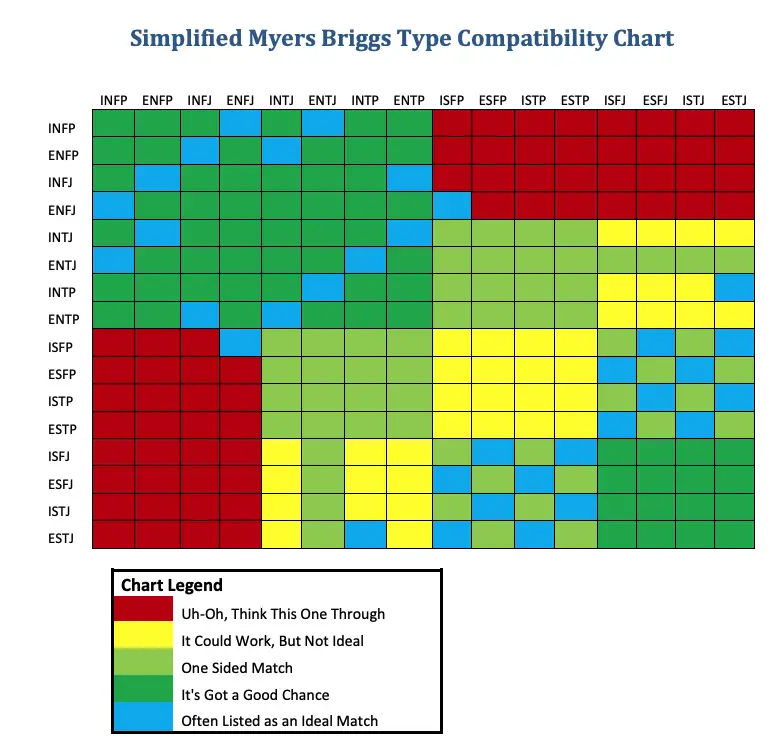MBTI Personality Compatibility
The concept of MBTI (Myers-Briggs Type Indicator) personality compatibility delves into how different personality types interact, communicate, and build relationships. The MBTI framework categorizes individuals into 16 personality types based on their preferences in four key dimensions. Understanding the compatibility between these types can provide valuable insights into how people with different traits can relate to and support each other:
Complementary Types
Complementary types are often attracted to each other due to the balance they bring. For instance, an Extravert (E) may find harmony with an Introvert (I), as the Extravert provides external energy while the Introvert offers introspection. Similarly, a Sensing (S) type's attention to detail complements an Intuitive (N) type's focus on patterns and possibilities, creating a holistic perspective.
Similar Cognitive Functions
Compatibility is enhanced when individuals share similar cognitive functions. For example, a Thinking (T) type may connect well with another Thinking type due to their shared emphasis on logical decision-making. Likewise, Feeling (F) types may understand each other's emotional sensitivities, fostering a supportive and empathetic connection.
Challenges and Growth
Challenges in interpersonal relationships, although often perceived as obstacles, possess the inherent capacity to catalyze substantial personal growth. This transformative process is particularly evident when considering the interaction between individuals with different personality traits. Take, for instance, the interplay between a Judging (J) type and a Perceiving (P) type within the Myers-Briggs Type Indicator framework.
At first glance, a Judging individual's structured and organized approach might seemingly clash with the Perceiving individual's flexible and adaptable nature. The inherent differences in their cognitive processes and decision-making styles could potentially spark conflicts or misunderstandings. However, beneath the surface-level discord lies a reservoir of opportunity for mutual enrichment.
When a Judging individual is confronted with the adaptable tendencies of a Perceiving counterpart, it beckons them to embrace a more open-minded and spontaneous outlook. The structured approach that once defined their interactions might give way to a willingness to explore uncharted territories, experiment with novel ideas, and entertain unconventional solutions. In essence, the Perceiving type's adaptability encourages the Judging type to recalibrate their rigidity, fostering personal growth through the expansion of their cognitive repertoire.
Conversely, the Perceiving individual embarks on their own journey of development. Exposed to the structured nature of the Judging type, they are presented with an opportunity to harness their innate potential for organization and strategic planning. The synergy of their partnership might inspire them to incorporate elements of foresight and intentional decision-making, transcending their inclination toward spontaneity.
Furthermore, navigating the challenges posed by such disparate personalities nurtures the development of essential interpersonal skills. Effective communication, compromise, and active listening become paramount in maintaining equilibrium within the relationship. As individuals strive to understand and accommodate each other's preferences and approaches, they inherently fine-tune their abilities to connect, collaborate, and coexist harmoniously.
The very differences that could give rise to initial tensions between a Judging and Perceiving type ultimately serve as catalysts for individual growth and mutual enrichment. The crucible of divergent perspectives fuels the evolution of their personalities, nudging them toward a more holistic and versatile self-awareness. Thus, what may appear as an initial challenge transforms into an invaluable opportunity for personal development, embracing change, and nurturing enduring bonds.
Communication Styles
Understanding communication styles is crucial for compatibility. Clear communication between an Extravert and an Introvert can prevent misunderstandings. Sensing types may appreciate concrete examples from Intuitive types, while Intuitive types can value the practical insights of Sensing types.
Shared Values
Compatibility is often rooted in shared values and goals. Individuals with similar values, even if they have different personality types, are more likely to support each other's aspirations and understand each other's motivations.
It's important to note that MBTI personality compatibility provides insights rather than strict rules. Individuals of any personality type can build successful relationships if they are willing to communicate, compromise, and appreciate each other's differences. Ultimately, personality compatibility offers a framework for understanding how different traits and preferences can contribute to harmonious interactions, both personally and professionally.


